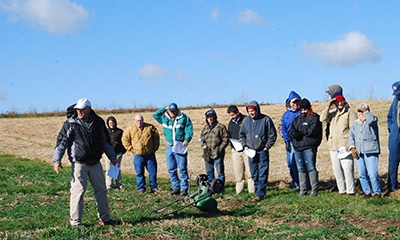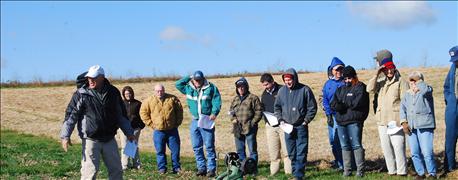May 3, 2016

How close are we to reaching Iowa’s Nutrient Reduction Strategy (NRS) goals? Well, we would need 6 million more acres of no-tillage, and 7,525 more wetlands, and 115,000 more bioreactors and 12 million more acres of cover crops. That is a lot of conservation! How do we get there? One field day and one workshop at a time.
While the Iowa Learning Farms uses many different outreach approaches, the importance of farmer-to-farmer interactions cannot be overstated. In other words, field days do matter.

SHARE THEIR EXPERIENCE: Field days help farmers gain knowledge and support they need to have confidence to increase their soil and water conservation practices. Once they are using conservation on their farm, they feel more comfortable networking with other farmers about the practices.
Field days and farmer workshops have been at the heart of ILF since its inception in 2004. Over the years, we’ve developed a multi-tiered approach to evaluation as a feedback mechanism to improve the effectiveness of our outreach. We call this our “Field Day Success Loop” based on the findings of our 2015 field day evaluation data. Before we go into the Success Loop, let’s look closer at the evaluation process and results.
ILF evaluations measure conservation education progress
In 2015, ILF held 31 field days statewide with 1,381 attendees. Participants at every field day are asked to sign in by filling out Comment Cards to gain a better understanding of who they are and why they are there. In addition, farmers and landowners are asked to complete Planning Cards to understand their intention to implement conservation practices.
Three weeks after the event, participants are mailed a Follow-up Evaluation that focuses on the clarity and accessibility of the information received and to ask if they plan to make any changes to their land management choices as a result of the event. The last tier of ILF’s process is a January Evaluation, mailed to only farmers and landowners to see if the participants did indeed make the changes they said they were going to make. In 2015, we got a 40% response rate to the two mailed surveys—an excellent result for a one-time mailing.
Highlights from evaluations taken at 2015 ILF Field Days:
•89% of the attendees were farmers and landowners.
• 93% of respondents rated the overall quality of the field day as good or excellent.
• Respondents reported planting 40,257 acres of cover crops in 2015, 35% of which were new acres of cover crops.
• ILF is reaching new potential conservationists. An estimated 38% of respondents used neither cover crops nor no-tillage on any of their acres.
• 71% said they networked with other farmers, and these respondents reported influencing 61% more farmers outside of the field day.
Field day attendees are networking with their peers, influencing farmers who did not attend the field day, thus creating a multiplier effect.
What is the relationship between attending field days, adopting conservation practices, networking and influencing other farmers? If a farmer attended three or more field days, they were more likely to report influencing other farmers than if they only attended one field day. We also found that the more cover crop acres the farmer reported, the more successful they were at influencing others to try conservation.Field Day Success Loop shows: Field days make sense!

Field days help farmers gain the knowledge and support they need to have confidence to increase their conservation practices. Once they are implementing conservation, they feel more comfortable networking with other farmers about the practices. The more conservation on their land, the more likely they are able to influence others to try conservation farming practices. This feedback loop continues with the conservation farmers playing a bigger role in encouraging other farmers to attend field days and to adopt conservation practices.
Can Iowa Nutrient Reduction Strategy be implemented?
The percentage of respondents who said they thought the goals of the NRS were achievable went from 55% in 2014 to 65% in 2015. That number jumps to 75% among respondents who planted more than 160 acres of cover crops in 2015. Among the respondents who weren’t using cover crops or no-tillage, 18% had never heard of the NRS and were significantly less likely to see the goals as achievable.
Field days and workshops do make a difference. If there is any hope of the NRS succeeding, we will need to significantly increase the number of conservation-focused field days across Iowa. A conservation field day or two in every county every year would be a great start. Iowa Learning Farms will continue to do its part. We are counting on good conservation farmers to use their influence to encourage neighbors to attend local field days and consider increasing conservation practices on the land.
At Iowa Learning Farms, we are excited to keep the good work going. Established in 2004, Iowa Learning Farms is building a Culture of Conservation, encouraging adoption of conservation practices. For more information about ILF, visit the website: www.extension.iastate.edu/ilf.
Editor’s Note: Jackie Comito is the program director for Iowa Learning Farms, based at Iowa State University.
You May Also Like




